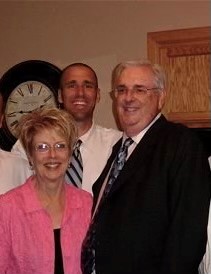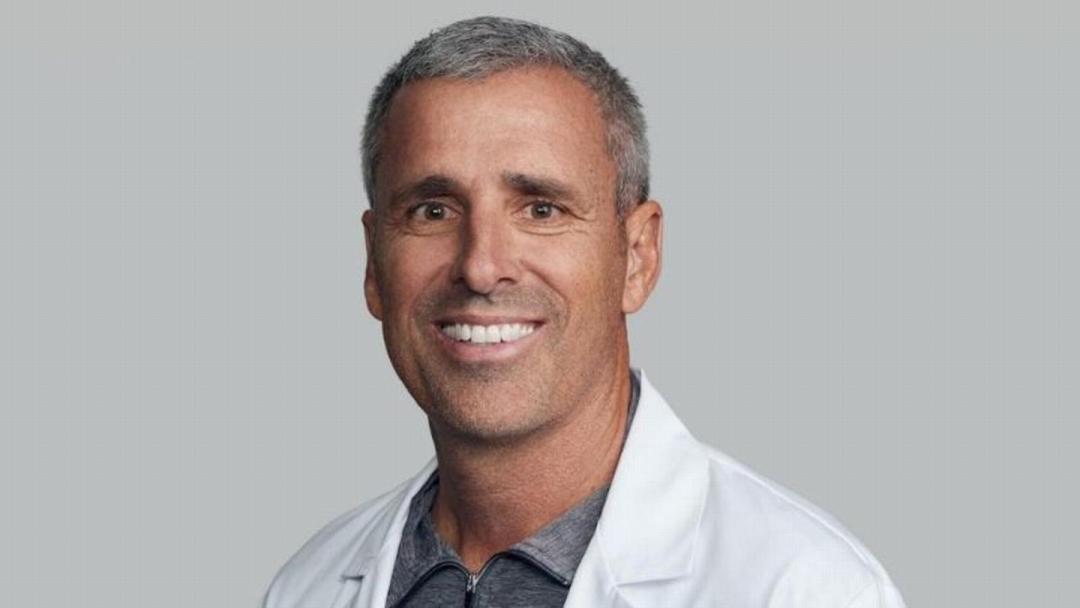Smack dab in the middle of a family of eight children, Dr. David Hatfield says his father always referred to him as the “pot stirrer.”
“I knew how to tease the older ones, but I also knew how to mess with the younger ones,” Hatfield jokes. “I’d create trouble on both ends.”
 Even though he was busy stirring the pot while growing up in Mesa, Arizona, he still found time to observe his father Dr. Kenneth Hatfield serving their community as a primary care physician.
Even though he was busy stirring the pot while growing up in Mesa, Arizona, he still found time to observe his father Dr. Kenneth Hatfield serving their community as a primary care physician.
“He literally did it all,” Hatfield says. “He delivered babies. He rounded on patients in the hospital. He covered shifts in the emergency room. If you were his patient and were in the ER, he would go meet you there and admit you, or discharge you home and have you follow up in his outpatient clinic the next day.”
Seeing his father’s impact on his patients was powerful enough to inspire Hatfield to become a primary care physician, too. He even attended the same medical school as his father, Kirksville College of Osteopathic Medicine, and worked beside him at his practice until his father retired.
Hatfield worked as a primary care physician for 23 years. Now the chief physician executive at Village Medical, Hatfield is looking back on his career in honor of National Primary Care Week, celebrated Oct. 1-7, and discussing how his thinking about U.S. healthcare has changed.
As it turns out, Hatfield’s father’s career path inspired more than one of his sons, and Hatfield eventually started a primary care practice with his brothers. Their practice grew to nine clinics and 35 providers in the East Valley of Arizona. But something wasn’t sitting right with Hatfield about how the practice was getting compensated for care. At the time, the practice was compensated for the quantity of healthcare services provided, a traditional fee-for-service model, where providers are paid for each service they provide.
“I knew the path that we were on in primary care and my medical group was not sustainable,” Hatfield says. “We couldn't continue to see high visit volumes and deliver quality.”
So, Hatfield pursued a master’s degree in medical management at the University of South Carolina, and while he was there, he had an “aha moment” when he learned about value-based care, which is where healthcare providers are compensated for patient outcomes.
“In other words, are you keeping folks out of the hospital? Are you helping folks stay well? It was really an epiphany moment,” Hatfield says. He knew in his bones that value-based care was the answer to transforming healthcare in his practice.
“My goal, at the very least, was to transform healthcare in the greater metropolitan area of Phoenix,” Hatfield says. “VillageMD had a much greater vision. They wanted to transform healthcare in America, and that's the mission we’re on now.”
So, how is VillageMD doing this? To start, they want to go where everybody is, Hatfield says.
“We want to take quality, compassionate care to every patient, every day in the communities we’re in,” he says. “And if we’re not in your community, we want to be in your community. Our focus is come one, come all.”
Reaching more people is the reason why VillageMD is so thrilled to partner with Walgreens, Hatfield says, because Walgreens has nearly 9,000 store locations nationwide. VillageMD has hundreds of Village Medical practices, and many are co-located alongside a Walgreens.
“Primary care should be visible and accessible, and the partnership with Walgreens has allowed us to be even more visible and accessible,” he says. “We want you to call us first, and we will navigate your healthcare.”
“You need to have those patient conversations around lifestyle changes, behavioral health and why certain tests or medications are necessary,” he says. “We also need to think about the social determinants of health that prevent a patient from accessing quality healthcare and we are trying to overcome those barriers at every turn.”
He spoke passionately about how Village Medical practices have banned the word “non-compliant.”
“Non-compliant is not a thing,” Hatfield says. “Say a guy named Joe, who’s sitting on a couch in El Paso, Texas, is not engaged in his healthcare. It’s not because he’s non-compliant; Joe just hasn't found his reason to live. He might not be too worried about his blood pressure if he doesn't know where his next meal is coming from, or he realizes he can't afford the next month’s rent.”
He says Village Medical tries to solve for social determinants of health in every community they serve.
“The secret sauce to primary care is having our patients know how much we care about them as individuals, as human beings,” Hatfield says. “And that’s how you tie together the dots of prevention. And if we do it one patient at a time, guess what, it spreads to the community that Village Medical is doing things differently.”
It's that personal care for the patient that can really make a difference—something Hatfield learned at a young age from his father.
“I got to witness firsthand what outstanding primary care looked like,” Hatfield says of his father. “At Village Medical, we’re putting the patient first and wrap around services that include care managers, social workers and clinical pharmacists, so we can give the patient a personal healthcare journey.”
“I knew how to tease the older ones, but I also knew how to mess with the younger ones,” Hatfield jokes. “I’d create trouble on both ends.”

Hatfield (back) with his mom (left) and dad (right).
“He literally did it all,” Hatfield says. “He delivered babies. He rounded on patients in the hospital. He covered shifts in the emergency room. If you were his patient and were in the ER, he would go meet you there and admit you, or discharge you home and have you follow up in his outpatient clinic the next day.”
Seeing his father’s impact on his patients was powerful enough to inspire Hatfield to become a primary care physician, too. He even attended the same medical school as his father, Kirksville College of Osteopathic Medicine, and worked beside him at his practice until his father retired.
Hatfield worked as a primary care physician for 23 years. Now the chief physician executive at Village Medical, Hatfield is looking back on his career in honor of National Primary Care Week, celebrated Oct. 1-7, and discussing how his thinking about U.S. healthcare has changed.
‘Aha moment’
As it turns out, Hatfield’s father’s career path inspired more than one of his sons, and Hatfield eventually started a primary care practice with his brothers. Their practice grew to nine clinics and 35 providers in the East Valley of Arizona. But something wasn’t sitting right with Hatfield about how the practice was getting compensated for care. At the time, the practice was compensated for the quantity of healthcare services provided, a traditional fee-for-service model, where providers are paid for each service they provide.“I knew the path that we were on in primary care and my medical group was not sustainable,” Hatfield says. “We couldn't continue to see high visit volumes and deliver quality.”
So, Hatfield pursued a master’s degree in medical management at the University of South Carolina, and while he was there, he had an “aha moment” when he learned about value-based care, which is where healthcare providers are compensated for patient outcomes.
“In other words, are you keeping folks out of the hospital? Are you helping folks stay well? It was really an epiphany moment,” Hatfield says. He knew in his bones that value-based care was the answer to transforming healthcare in his practice.
Transforming healthcare in America
Shifting to a value-based care model isn’t like flipping a switch; to at least get started, Hatfield says you need to have scale and put the right workflows in place. When he met the founders of VillageMD, he realized they were trying to do the same thing, and they joined forces.“My goal, at the very least, was to transform healthcare in the greater metropolitan area of Phoenix,” Hatfield says. “VillageMD had a much greater vision. They wanted to transform healthcare in America, and that's the mission we’re on now.”
So, how is VillageMD doing this? To start, they want to go where everybody is, Hatfield says.
“We want to take quality, compassionate care to every patient, every day in the communities we’re in,” he says. “And if we’re not in your community, we want to be in your community. Our focus is come one, come all.”
Reaching more people is the reason why VillageMD is so thrilled to partner with Walgreens, Hatfield says, because Walgreens has nearly 9,000 store locations nationwide. VillageMD has hundreds of Village Medical practices, and many are co-located alongside a Walgreens.
“Primary care should be visible and accessible, and the partnership with Walgreens has allowed us to be even more visible and accessible,” he says. “We want you to call us first, and we will navigate your healthcare.”
Caring for patients and their communities
The other important piece to making value-based care work, Hatfield says, is helping one patient at a time with prevention.“You need to have those patient conversations around lifestyle changes, behavioral health and why certain tests or medications are necessary,” he says. “We also need to think about the social determinants of health that prevent a patient from accessing quality healthcare and we are trying to overcome those barriers at every turn.”
He spoke passionately about how Village Medical practices have banned the word “non-compliant.”
“Non-compliant is not a thing,” Hatfield says. “Say a guy named Joe, who’s sitting on a couch in El Paso, Texas, is not engaged in his healthcare. It’s not because he’s non-compliant; Joe just hasn't found his reason to live. He might not be too worried about his blood pressure if he doesn't know where his next meal is coming from, or he realizes he can't afford the next month’s rent.”
He says Village Medical tries to solve for social determinants of health in every community they serve.
“The secret sauce to primary care is having our patients know how much we care about them as individuals, as human beings,” Hatfield says. “And that’s how you tie together the dots of prevention. And if we do it one patient at a time, guess what, it spreads to the community that Village Medical is doing things differently.”
It's that personal care for the patient that can really make a difference—something Hatfield learned at a young age from his father.
“I got to witness firsthand what outstanding primary care looked like,” Hatfield says of his father. “At Village Medical, we’re putting the patient first and wrap around services that include care managers, social workers and clinical pharmacists, so we can give the patient a personal healthcare journey.”
